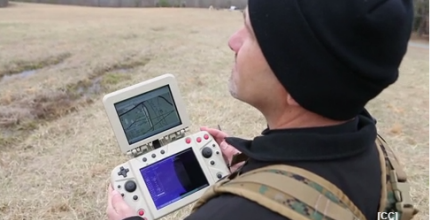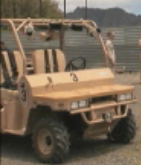12 battlefield tools of the future Marine
The Marine Corps Warfighting Laboratory this week is testing a variety of new technologies and gear at its Advanced Warfighting Experiment. Here’s a rundown on a dozen of them.
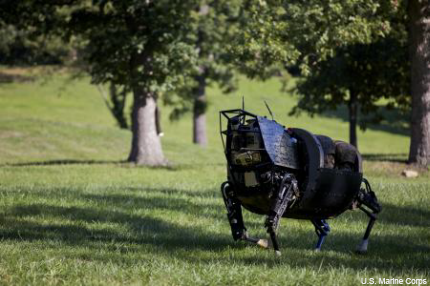
The soldier of the near future—or more specifically, soldiers’ next-generation tools—are getting a test run this week in Hawaii, as the Marine Corps Warfighting Laboratory conducts its Advanced Warfighting Experiment (AWE). Starting today and running through July 14, technologies ranging from robotic pack mules and wearable power sources to lightweight water purification systems will take the field in exercises designed to assess their effectiveness.
Here’s a look at some of the technologies the Marines will be fielding.
Robotic pack mule
Officially called the Legged Squad Support System, or LS3 (and also known as Alpha Dog), the robot, pictured above, was developed by the Defense Advanced Research Projects Agency and Boston Dynamics (since bought by Google) over several years. It can carry about 400 pounds of gear over rough terrain, has sensors that allow it to navigate in the dark or adjust to changes in the terrain and can respond to voice commands.
The Ground Unmanned Support Surrogate Autonomous Internally Transportable Vehicle looks like a Jeep but is packed with sensors that allow soldiers to operate it conventionally or via remote control. It also can work semi-autonomously.
STS and Tactical Tele-Medicine
The Shock Trauma Section is a comprehensive mobile system that encompasses vehicles, shelters, medical devices, blood storage and power supplies to improve trauma care in the field. It can be transported by the Marines’ air support vehicles. The Tactical Tele-Medicine unit is a ruggedized, portable patient monitor that can be used in the field to collect vital signs and transmit video and audio over the tactical network.
TRC
The Tactical Robotic Controller looks like a gaming console but gives Marines control of a variety of unmanned systems, including air and ground vehicles and LS3—34 systems in all. By supplying a common control, the wearable device cuts down significantly on the amount of gear needed in the field. Though the hardware has a familiar look and feel for users, each device has a different interface; the Marines’ next step is to simplify the interfaces.
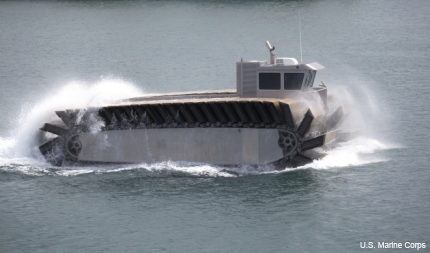
UHAC
The Ultra-Heavy Amphibious Connector is a prototype vehicle with a unique tracking system that gives it mobility over water and rough terrain. It has three times the lift capacity, as well as greater coastal access, than the Landing Craft Air Cushion. The warfighting lab has been experimenting with a roughly half-scale model, but the full-size UHAC would be able to carry at least three tanks and a High Mobility Multipurpose Wheeled Vehicle.
GUSS AITV
The Ground Unmanned Support Surrogate Autonomous Internally Transportable Vehicle looks kind of like a golf cart but is packed with sensors that allow soldiers to operate it conventionally or via remote control. It also can work semi-autonomously.
ME-L
The Marine Air Ground Force Task Enabler-Light serves is vehicle-mounted command and control hub with DTCS, NGC2 and Ku-and satellite radios. It connects to the Global Information Grid and serves as the combat operations center for company landing teams.
HEIT
The Hybrid Energy Internally Transportable Vehicle Trailer is a multipurpose energy supply, allowing units to draw power using fossil fuels, solar panels, batteries and other sources—in other words, whatever’s available. Currently in the concept-demonstrator phase, the two-wheeled trailer attaches to the back of a vehicle, giving Marines a versatile, transportable source of electricity.
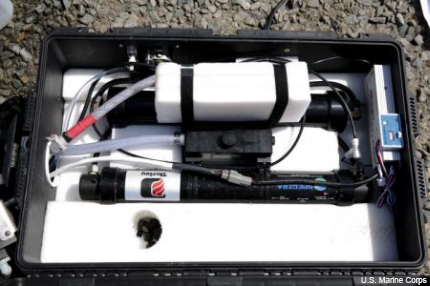
SUWP
The Small Unit Water Purification system lets platoons tap available water in the field, cutting down on the logistical demands of sending resupplies. The experimental unit weighs 75 pounds—not a featherweight but a lot lighter than an industrial purification systems—and can purify seven to 10 gallons of water an hour from local sources.
FMC
The Foot Mobile Charger is a wearable power supply that generates electricity through movement and can power devices carries by the soldier. The Marines have tested variations of wearable power sources before, but for the AWE will be using the Marine Austere Patrolling System, which includes individual water purification and storage capacity.
MANET management
Communications in remote areas often require a Mobile Ad-Hoc Network, or MANET. During the AWE, the Marines will be using several tools designed to supply seamless information sharing and situational awareness, including the simply titled Network Management System, software that lets Marines manage the MANET. Also part of the exercise are the Distributed Tactical Communications System, or DCTS, and Next Generation Command and Control (NGC2), which comprise over-the-horizon radios that deliver voice, data and position location.
ICA
The Integrated Capabilities Application is a local area network in a virtual environment that links legacy and stand-alone systems to provide a common operational picture and better situational awareness. ICA can be scaled to user needs, depending on the size of an operation.
HART
The Heterogeneous Aerial Reconnaissance Team is an IP based architecture that links unmanned aerial vehicles with users on the ground, contributing UAVs’ sensor data to the common operating picture. HART has been integrated into the Raven, Stalker and Scan Eagle UAVs.





